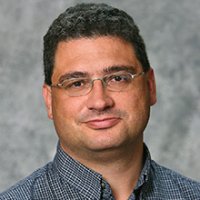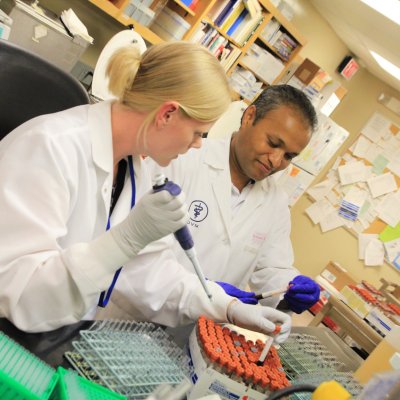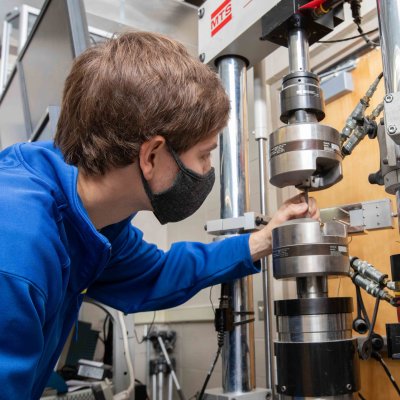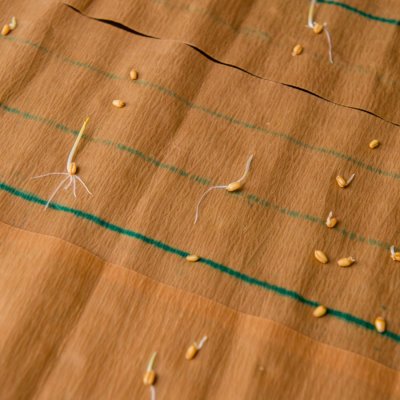Infrastructure vital to discovery
Core facilities and service laboratories serve essential functions at South Dakota State University.
Our core facilities support faculty research by providing tools and equipment that can be utilized by multiple users. Meanwhile, the service laboratories offer assistance to the public. For example, someone can bring in seed samples and have it analyzed for a fee at our Seed Testing Laboratory.
These laboratories and facilities also work as learning centers for our students in both high-tech developments and research efforts.
SDSU’s infrastructure continues to evolve as we provide the means to better assist our faculty researchers and scientists, who continue to make groundbreaking breakthroughs in their disciplines.
The Research Core Facilities (RCFs) seek to enable research by providing access to equipment, technologies too expensive for single labs to operate, and expertise to researchers needing it1.
In the context of multidisciplinary and team-based science RCFs are essential to facilitate the use of technologies and approaches outside of the researchers’ expertise. RCFs have been defined as “a collaborator that will not say ‘no’ unless there are technical feasibilities concerns”
Research Core Facilities offer potential benefits such as:
- Increased utilization of the infrastructure and broader access to state-of-the-art services, facilities and technologies offered by centralizing its management and operation.
- The strategic development of proposals, with a focus on the promotion of interdisciplinary collaborations, while avoiding duplication of infrastructure.
- A better utilization of resources through economies of scale and cost savings, and reduced duplication of efforts.
- Enhanced training for students, staff, and faculty which leads to greater availability of technical expertise.
- Enhanced attraction and capacity to work with external users.
- An improved capacity to sustain the research infrastructure over its useful lifetime.
Currently SDSU has four active RCFs:
- Functional Genomics Core Facility, located in McFadden Biostress building. This facility provides access to high-end light microscopy and some general molecular biology equipment. This facility is a self-service facility, where users are trained in the use of the equipment and reserve time for each equipment. Users are charged an hourly fee. The facility has a faculty director/coordinator and a full-time research scientist supported by the Ag. Exp. Station.
- Mass Spectroscopy Core Facility, located in the Avera Building. The facility provides access to mass spectroscopy analytical equipment. This facility is a hybrid facility where users can be trained and then reserve and use the equipment with an hourly use fee; users can also request their samples to be analyzed by the Research Associate supporting the facility. The facility has a faculty director/coordinator and a full-time research scientist, supported by the College of Natural Sciences, and also helps develop isolation methods for compounds of interest.
- Genomics Sequencing Facility, located in the Young Brothers Seed Technology Building. This facility provides nucleic acid sequencing services. The facility is full-service where users submit their samples for sequencing and are charged a fee based on the runs of the instrumentation and supplies used. In addition to a faculty director, the facility is supported by a postdoctoral scientist supported by grants, and a research associate supported equally from grants and the Ag. Exp. Station.
- High Performance Computing. This facility is part of the Division for Information Technologies and provides access to computing clusters and high-end servers for research computing. The facility also provides support by installing new software and helping optimize run performance.
There are opportunities to develop other RCFs including one or more housing equipment and expertise in materials characterization and microfabrication.
A RCF should have a faculty director/coordinator (~20% dedication) leading the technical expertise and financial management of the facility resources; depending on the mode of operation each facility should have 1 or more technicians to train users, maintain equipment, and process samples.
Some management recommendations include:
- To protect the facilities directors from negative impacts in promotion and tenure processes, a specific annual review should be included in the faculty’s promotion/tenure dossier.
- Develop clear best financial practices for facility directors to follow and consider unifying invoicing practices under a common management software.
- Consider acquiring/subscribing common facility management software for equipment reservations, used monitoring and invoicing.
- To ensure proper recognition we should develop acknowledgment and authorship guidelines for facility personnel.
- To better capture facilities impact and improve success in future equipment funding opportunities, a manuscript and grant proposal reporting system should be developed with corresponding policy clearly explained to faculty and researchers.
This is a 5-year development plan with the overall goals of:
- Improving awareness and trust in the RCFs among campus stakeholders.
- Having an established mechanism of support for RCFs.
- Integrating RCFs in the educational, training, and outreach offerings of the University.
Year 1 goals:
- Have 1-2 RCFs with a higher user base.
Year 2 goals:
- Have 1-2 facilities with higher use.
- Update webpages regularly to highlight research applications made possible by each RCF.
- Make regular presentations/seminars to colleges and departments.
- Have established 1-2 additional high-priority RCFs.
- One of these facilities will be a Material Characterization RCF.
- Develop a feedback mechanism to gather information on potential new RCFs and new instrumentation/applications.
- Have established a plan for support and continuity of RCFs.
- Develop a budget plan to present to ADRs, Deans, Provost, and President
- Have started integration of RCFs in internal education and training.
- Develop one training workshop per RCF.
- Work with Graduate School on a pathway to validate those workshops as credits.
Year 5 goals:
- Have established three additional high priority RCFs.
- Have all RCFs at higher use.
- Have the RCFs integrated in internal and external educational, training and outreach opportunities.
Service Laboratories
Core Facilities
Genomics Sequencing Facility
We provide DNA/RNA sequencing, library prep, extractions, PCRs, QC, and bioinformatic analysis services using Illumina platforms and automation, and can collaborate on experimental design.
For more Information

Jose Gonzalez
Research Core Facilities Director and Professor
Division of Research and Economic Development
Department of Agronomy, Horticulture and Plant Science
Genomics Sequencing Facility




